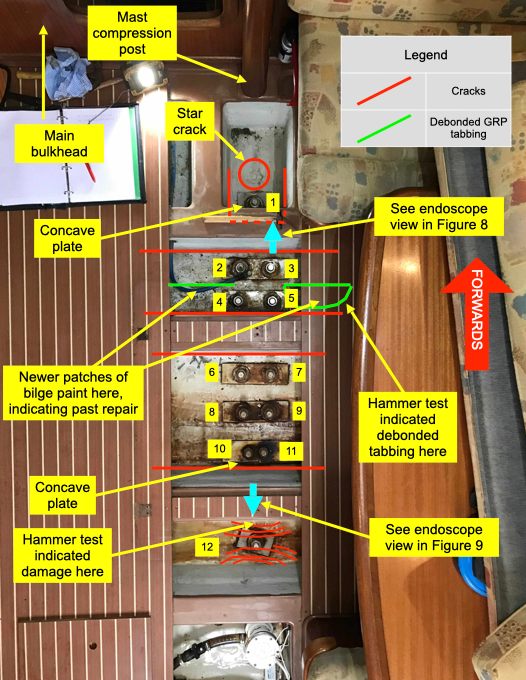
I was recently asked by a GRP repair specialist to investigate the gap in a hull-to-keel join of a 42' GRP sailing yacht. The gap at the aft end of the damaged keel quite clearly indicated that part of the hull structure had failed, but the internal structure required closer examination in order to find the cause of the movement.
Using a combination of visual inspection, hammer testing and endoscope examination, the areas of damage of the internal hull stiffening structure were found and recorded.
Whether the boat was sitting with its weight on the keel or with the keel dangling in the air, it was not possible to see any movement or gaps appearing around any of the 12 stainless steel keel fastening studs or the surrounding hull structure. For health & safety reasons, I wasn't able to sit inside the boat and observe what happened to the internal structure when the hoisted boat was lowered down onto its keel. I suspected that there was a gap between the hull and the GRP moulding of the internal stiffening structure. Movement of this gap would explain the 5 mm gap seen on the outside of the boat. This gap could have been found by cutting away part of the internal stiffening structure, but this was deemed to be a last resort. I inserted an endoscope into the 'top hat' section of the internal stiffening structure that was located nearest to the aft-most keel stud. Although the resolution was poor and the image looked more like something out of Monsters Of The Deep, or a lurid porn movie, it was clear that there was some sort of dark space or gap between the lower flange of the 'top hat' section and the hull.
Not convinced? I wasn't sure either, so I set the endoscope to record a video of the image and I got off the boat. The crew of the lifting hoist then lowered her back into her cradle. In this cradle, some of the boat's weight is supported by four large steel supports, with the rest of the weight on the keel.
Apologies for the quality of this video. It had to be severely shortened for me to upload it onto the website. To explain the video, you have to imagine that the endoscope lens is sitting on the floor of the hull. When the boat was lowered into the cradle, the keel pushed up the hull, which is seen in this video as the shiny upper bit moving downwards. The shiny bit is the vertical web of the 'top hat' section.
The next step is for the GRP repair specialist to find the time in their busy schedule to remove the damaged keel and to repair the damage in the hull internal structure.
Take a look at the following link for a copy of the survey report (names and locations changed): https://fieldhouse-yacht-surveys.com/wp-content/uploads/2021/03/FYS_KEEL_DAMAGE_REPORT_issue_1.pdf




3 Responses